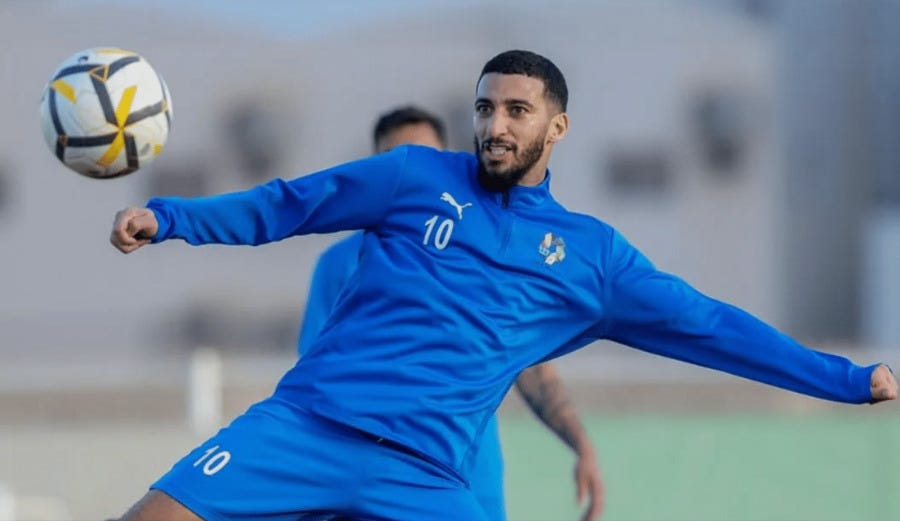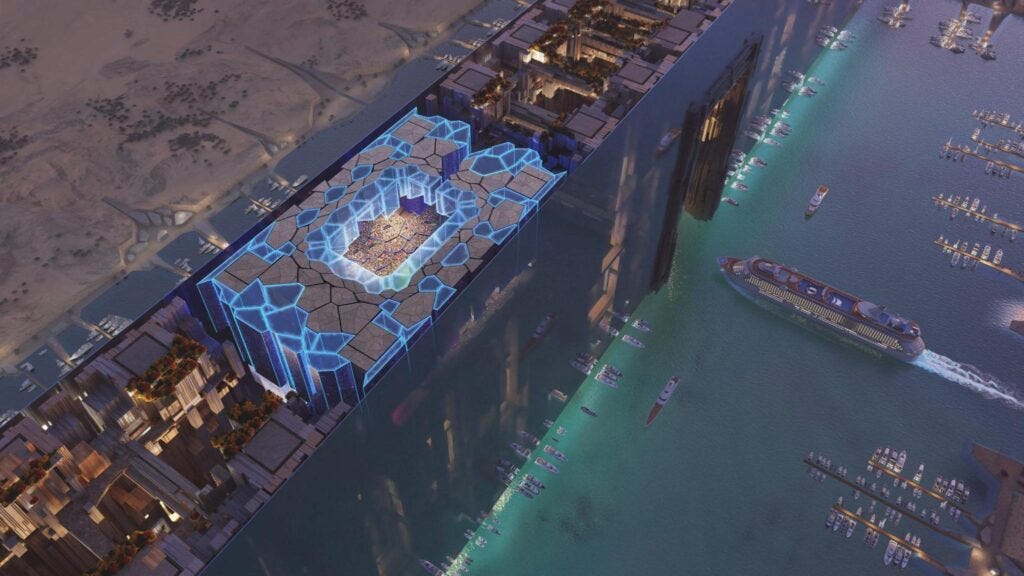Walk The Line: NEOM SC, the New Frontier of Saudi Football-Politics
Neom SC in an emerging powerhouse in Saudi football, and it is the front line of a futuristic project called The Line. Under which hide atrocious stories of violence and exploitation.

The January window of football transfers seems to have marked the rising of a new strategy for Saudi Pro League clubs. As Gavin Gibbon argued on Arabian Gulf Business Insight, the priority now is to recruit more younger footballers than famous over-30 top players: last month, football fans saw Neymar leave Al-Hilal and return to Brazil, while more than half of the new signings of the league aged 23 or less. The best example of this strategy is of course Jhon Durán, 21-years-old Colombian striker, considered one the best talents in the Premier League during the last two seasons with Aston Villa, bought by Al-Nassr for at least €77 million and a year salary of €20 million.
Durán signing clearly made the headlines of the January transfer window in Saudi Arabia, but there was another important deal which however did not have as much prominence: the one of Saïd Benrahma. Surely not as known as Durán, Benrahma is a 29-years-old Algerian winger who played for Olympique Lyon and previously for Brentford and West Ham United. Not a superstar, but clearly a high profile name for the Saudi football, especially for his new team. He has in fact found an agreement with a second tier but extremely ambitious club, called Neom SC. Born less than two years ago, Neom SC will almost certainly play in the next Saudi Pro League season, and it could become one of the most prominent football club in all the country. But there is more than that: Neom SC is the front line of a great urbanistic and economic project, The Line.
The Rise of Neom SC
At the beginning of June 2023, Saudi state fund PIF took control of 75% of four first division clubs (Al-Ittihād, Al-Nassr, Al-Hilal and Al-Ahli), starting a sumptuous international transfer campaign. At the same time, the Ministry of Sports announced that a third division club named Al-Suqoor (founded in 1965 but never became relevant in the country) would be purchased by the state company Neom. That summer, Al-Suqoor bought 15 new players, including Ghanian international winger Samuel Owusu from Serbian club FK Čukarički. Then, in December, it changed its name in Neom Sports Club, becoming an official testimonial of its owner company. At the end of the season, Neom SC won the league and began another great transfer window in Summer 2024: it bought 11 players from top tier club such as Al-Ittihād and Al-Hilal (including 2017 Club World Cup top scorer Romarinho, Egypt international defender Ahmed Hegazy and Saudi Arabia captain Salman Al-Faraj), and also former Juventus and Galatasaray striker Mbaye Diagne, and former Nottingham Forest and Reading midfielder Alfa Semedo.
Neom SC spent almost €20 million: an enormity, compared to the other clubs in the championship. The 21-years-old right back Abdulmalik Al-Oyayari was signed from Saudi Pro League club Al-Taawoun for €8.5 million, becoming the second most expensive Saudi player of the season after Moteb Al-Harbi (bought by Al-Hilal for €29 million from Al-Shabab). Neom SC chose also a new coach, the 58-years-old Brazilian Péricles Chamusca, and a new CEO was named in November: Alex Leitao, another Brazilian, who worked for Athletico Paranaense and Orlando City. The club has an absolute economic power in the Saudi second division: according to Transfermarkt data, Neom SC has a market value of €1.16 million and a roster value of €29.03 million. To make a comparison, the second richest club in the league (Abha Club) has just €210,000 of market value and €6.51 million of roster value. And in January 2025 Leitao bravely decide to sell the 34-years-old club top scorer Romarinho to buy Benrahma and the promising Saudi-Canadian forward Ahmed Al-Ghamdi (paid almost €4 million to Al-Ittihād). Neom Sc is currently top of the league with 38 points in 19 matches (11 wins, 5 draws and 3 defeats).
This emerging Saudi superclub is not just dealing with transfers, but also with the stadium issue, the most relevant project of Neom SC. At this moment, the team plays its home matches in Khalid Sport City Stadium, a 12,000-seats arena in Tabuk, the original Al-Suqoor city in North Saudi Arabia. Tabuk is a 594,350-inhabitants city close to the Jordan border, mainly known for its large air force base. But obviously the future of Neom SC is to resetting 150 km to the West, in front of the Red Sea, where the owner company is building a futuristic urban area called - surprisingly - Neom. Inside Neom there will be an extravagant ideal city named The Line, which will host the 46,000-seats Neom Stadium. The project is to start building the arena by 2027 and have it finished by 2032, two years before the World Cup.
The Line: Inside Neom Ambiguous Utopia
Neom was created in 2019 by PIF to organize the development of a 26,500 km2 and 9 million people urban area in West Tabuk region, between the desert and the Red Sea. The project, originally launched in 2017, includes multiple regions, part of an extensive planned area which aim is to develop Saudi Arabia well beyond Riyadh and diversify its economy. Everything goes around The Line, a high-tech linear city housed in a single building, without cars, streets and 100% eco-sustainable. It is probably the most ambitious project included in Saudi Vision 2030, and its promises are the manifesto of what Saudi Arabia want to be in the near future. The entire Neom area will cost $1.5 trillion and it will be ready for 2039, Saudi authorities said in the past years, but now it seems these plans were too far optimistic: at the end of January 2025, Deputy CEO Rayan Fayez told at the World Economic Forum in Davos that it will take a century to build and populate the whole area.
Riyadh government included the Neom Stadium between the host cities of the 2034 World Cup, so in 10 years there will have to be a complete arena connected with hotels, restaurants, transports and everything needed by the tourists who will arrive in the country. Here will be played some matches of the group stages, round of 32, round of 16 and of the quarterfinals, according to the Saudi bid. The project was initially entrusted to the Danish firm Bjarke Ingels Group, but now it seems the stadium will be realized by Populous, which is also behind four more 2034 World Cup venues (and behind the Stade Hassan II in Casablanca too, that will be the largest arena on the planet and will probably host the 2030 World Cup final).
But will this facility be ready for 2034? Neom Stadium will be built 350 metres above ground, on the fourth and fifth tier of The Line, where Saudi government plans to host VIP hotels for FIFA officials. It is not a stand-alone project: the stadium can exist only if the entire city exists. But, as we saw, the forecasts have changed. The Line will be a 170-km-long city, but for the deadline of 2030 no more than 2.4 km are expected to be built, and the original 1.5 million population has been recalculated in less than 300,000. With these premises, it seems that the utopian city in the desert will be rather a ghost town, with a giant stadium surrounded with big empty hotels. It will also be difficult to fill the arena after the World Cup: at the moment there are no club in Saudi Arabia with an average attendance higher than 33,000 (Al-Ittihād), and only four clubs count more than 10,000 spectators per game. But even more problematic will be the 2029 edition of the Asian Winter Games, which will be hosted in Neom, with a tremendous environmental impact.
The Future of Violence and Exploitation
If the idea of a failure of the entire Neom project is concerning, its success will surely be even worse. Under the veil of the ideal city of the future lies a story of atrocities, that starts with the forced expulsion from the area of the Howeitat people, the Arab tribe living in the region from the XVIII century. In April 2020, Abdul Rahim al-Huwaiti, an activist of the Howeitat tribe, was killed by security forces for trying to resist the evictions. Other people were arrested in the following days, and three of them were later sentenced to death. In May 2024, Rabih Alenezi - a former intelligence officer who worked at Neom project and in 2023 defected to United Kingdom - claimed that Riyadh government authorized the use of lethal force to ensure the smooth progress of the work in the area.
The people who work on Neom's construction sites are, as you can imagine, exploited migrant workers, mostly from Bangladesh. Almost 15 of them went on strike in October 2024, in the same days when Saudi authorities inaugurated Sindalah, Neom’s luxury resort area, at the presence of Yasir Al-Rumayyan, the governor of PIF and chairman of Newcastle United. But because in Saudi Arabia strikes have no legal recognition, the workers were fired, losing their apartments. One of them told to Josimar’s journalists Samindra Kunti and Andreas Selliaas that they protested because of non-payed wages: they worked for Transcend Arabia through a subcontractor, which never payed them for 190 hours. “Neom rules are good, but then you have subcontractor, and subconctractor… Mine was not good.” said a 28-years-old Bengali worker.
The working conditions are no different from those of other construction sites in the country. Saudi laws allow working for no more than 60 hours maximum, but an ITV documentary revelead last October that this rule is systematically disregarded: workers building The Line testified that they have to endure 16-hour shifts, 14 days straight. “We don’t get enough rest. This lack of sleep has caused many accidents. There have been many. Just last month, there were four or five cases” said one of them. Neom responded that it will assess these claims, checking if all contractors and subcontractors comply to its Code of Conduct, and stating that “they are subject to frequent inspections of their workers’ living and working conditions”. Yet, nothing already seems to have changed, and at the end of January 2025 FIFA rejected calls for an independent monitor to assess migrant workers’ conditions made by the African Regional Organisation of the International Trade Union Confederation (ITUC-Africa).







